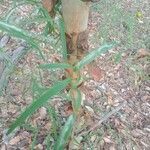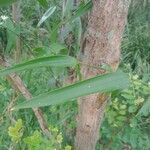An evergreen vine. It forms a tuber at the base. This is 1-3 cm long. It climbs to a height of 10 m. It can spread over the ground. The stem is slender, wiry and twining and forms many branches. The leaves are oval or sword shaped and taper towards the tip. They are 6-10 cm long and have prominent veins. Sometimes the leaves are wavy along the edge. The flowers are white or pale pink and have 3 petals and 3 petal-like sepals. The flowers are clustered in the axils of the upper leaves. They are bell shaped. The fruit are round, orange berries. These split to reveal the shiny black seeds. The fruit are 1 cm across.
Shrub or climber to 5 m. Leaves ovate to linear, acute; lamina 2.5–12 mm long, 2–35 mm wide; petiole 0.5–1 mm long. Pedicels several, clustered in leaf axils, 8–15 mm long. Flowers 10–18 mm diam., pale pink to mauve, fading to white. Sepals and petals 5–8 mm long. Stamens 4–7 mm long; filaments flattened; anthers 2–4 mm long. Ovary ovoid, 2–3 mm long, glabrous; style c. 5–7 mm long; stigma minutely ciliate. Capsule 10–20 mm diam., yellow-orange. Seeds ± globose, somewhat angular; testa hard.






